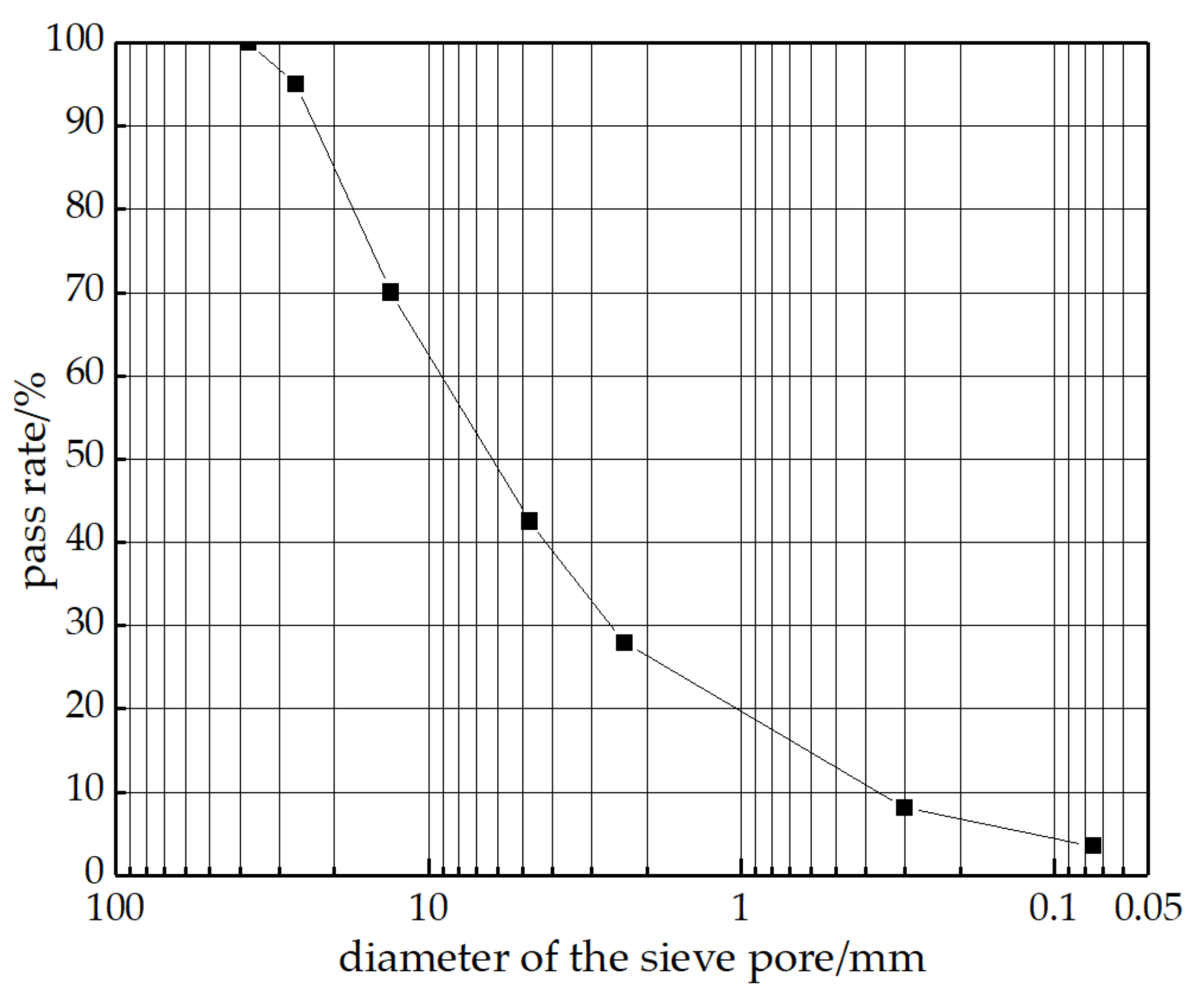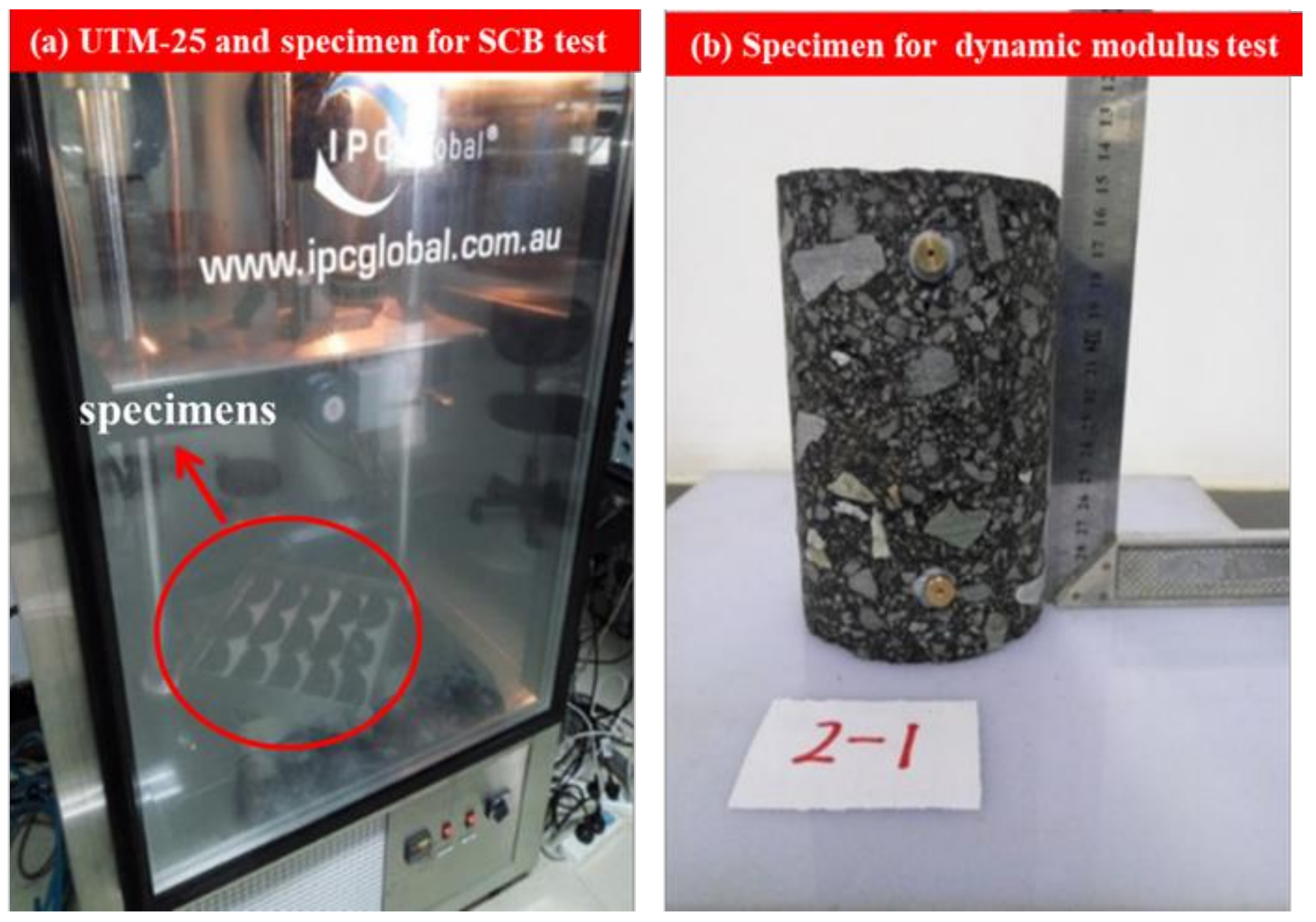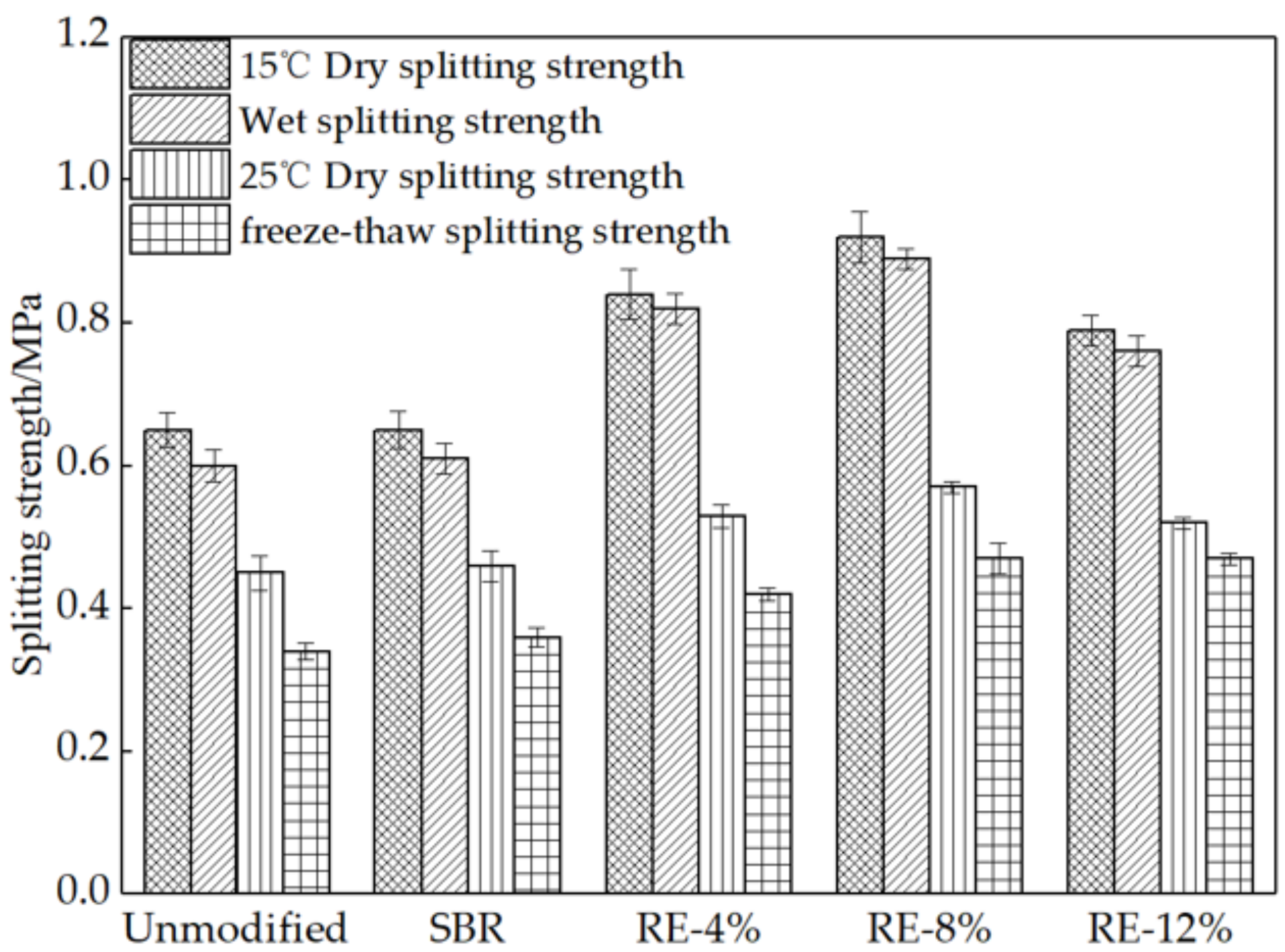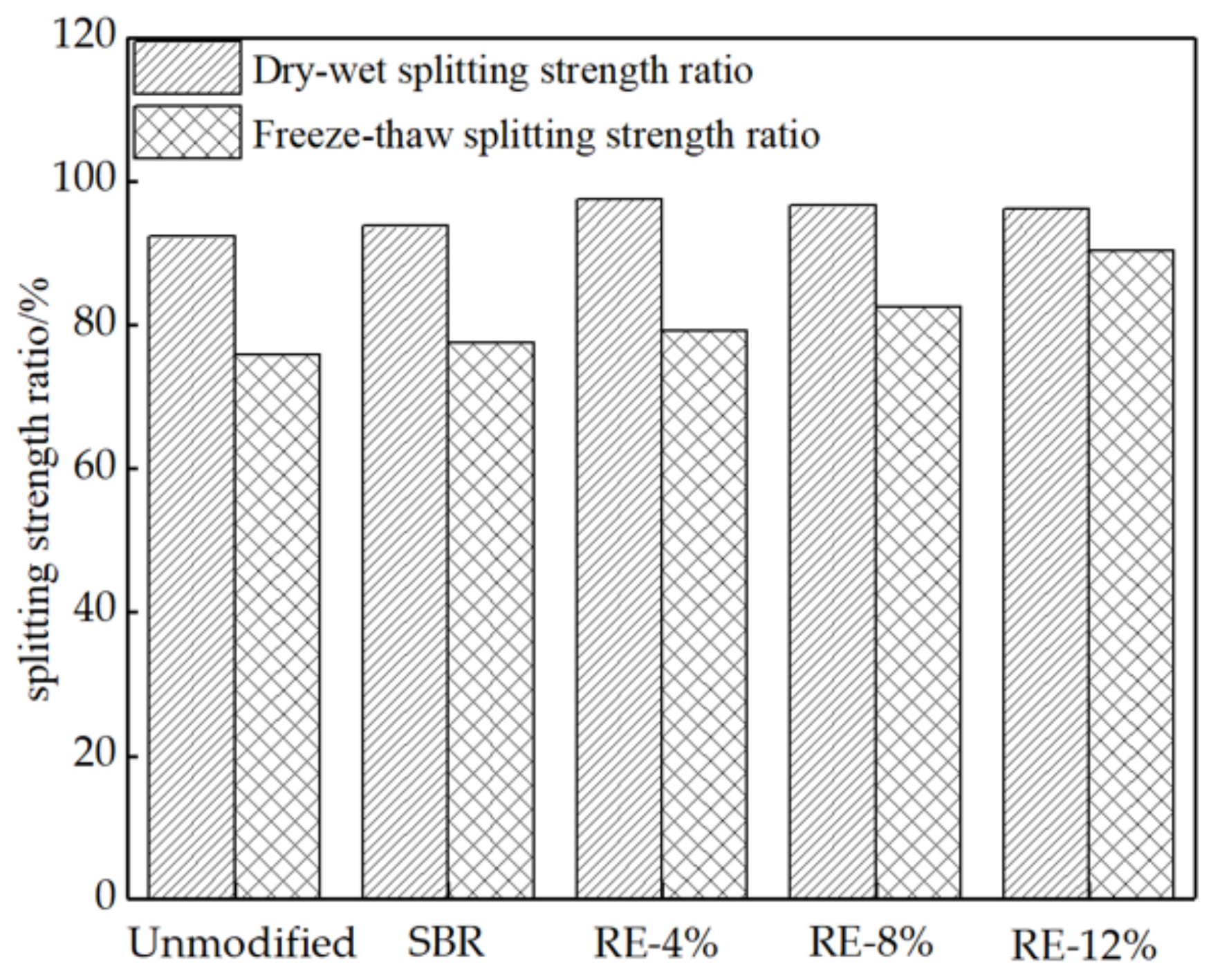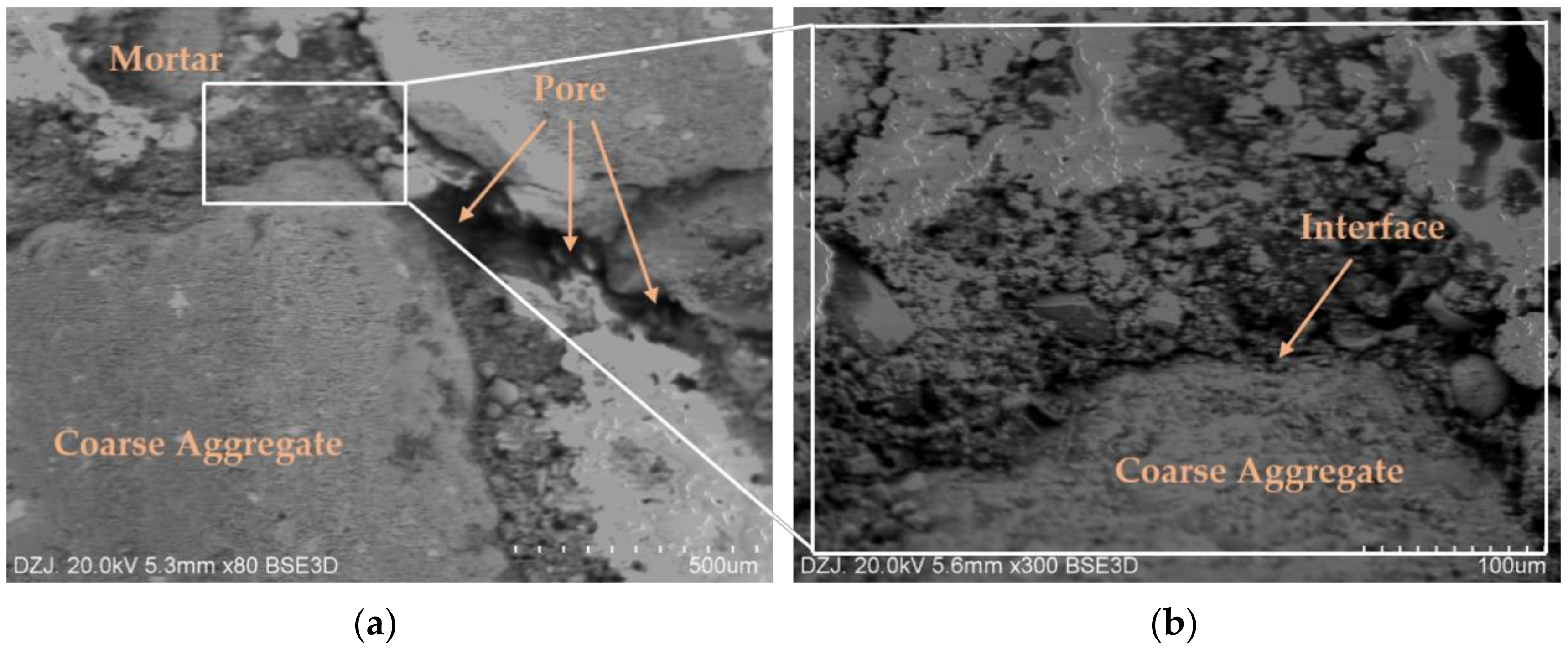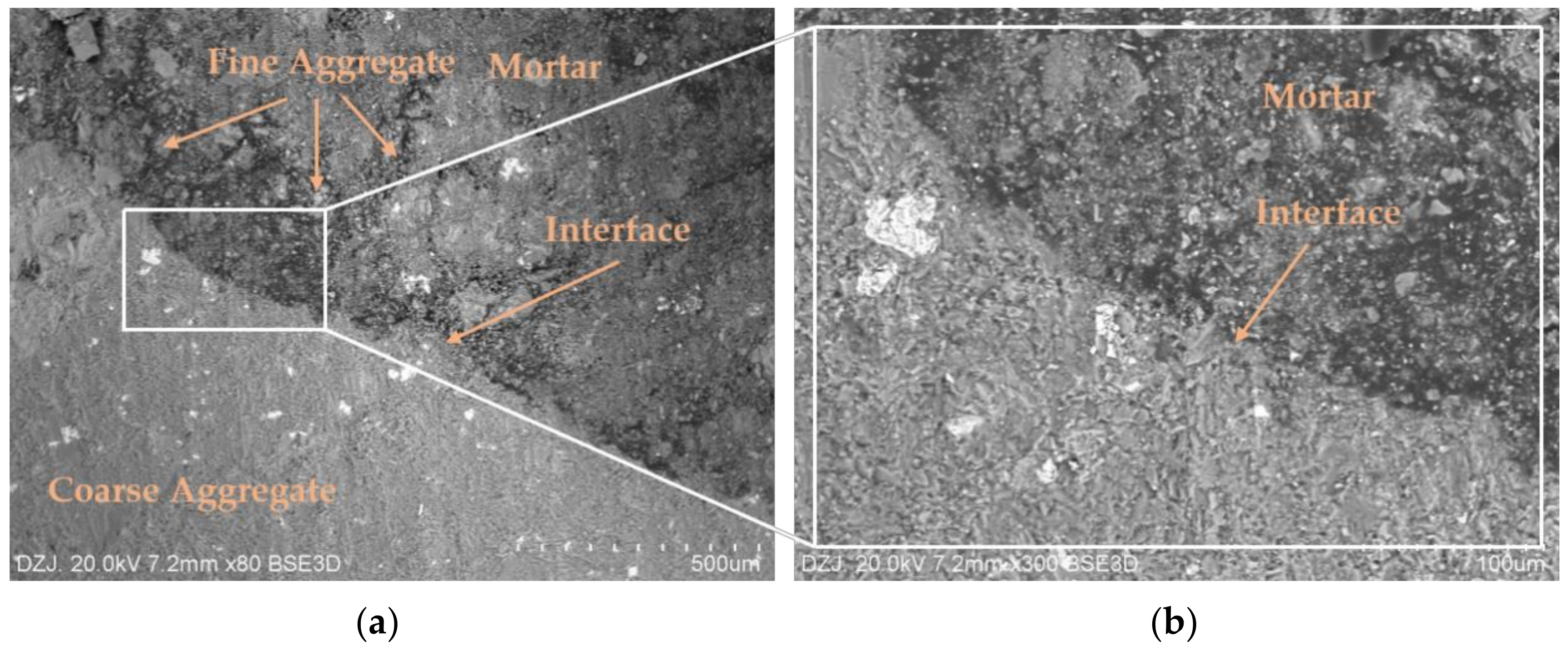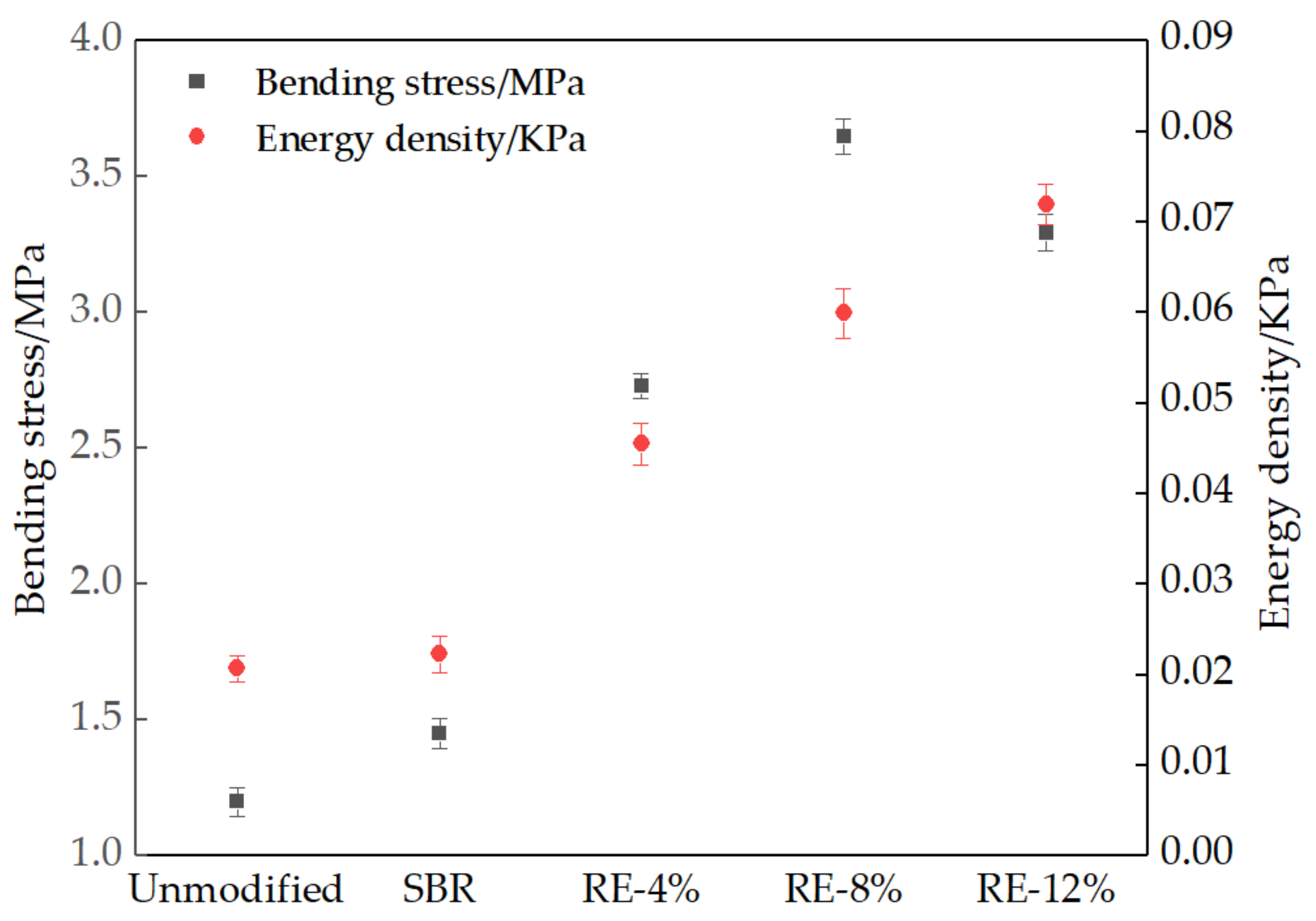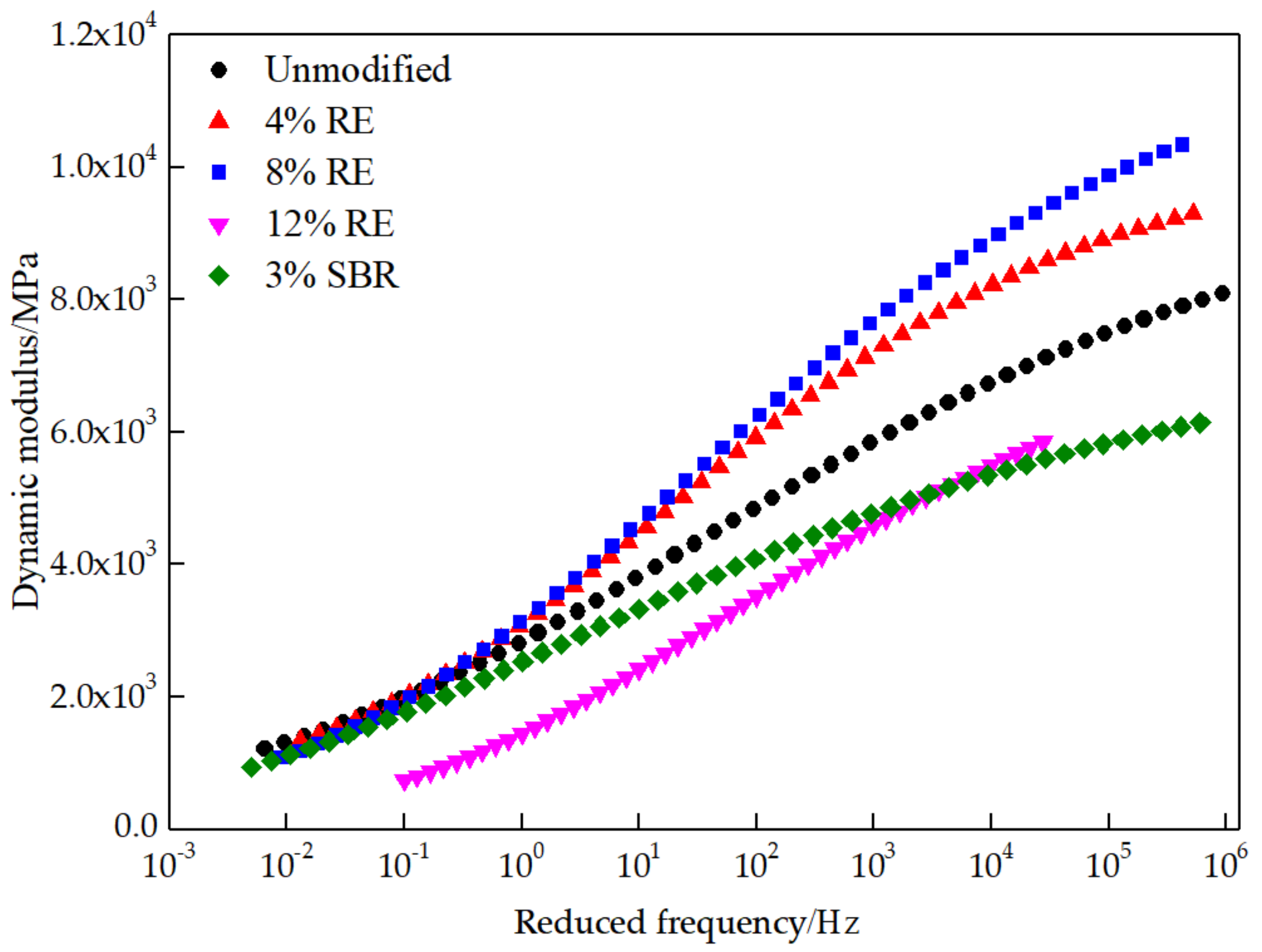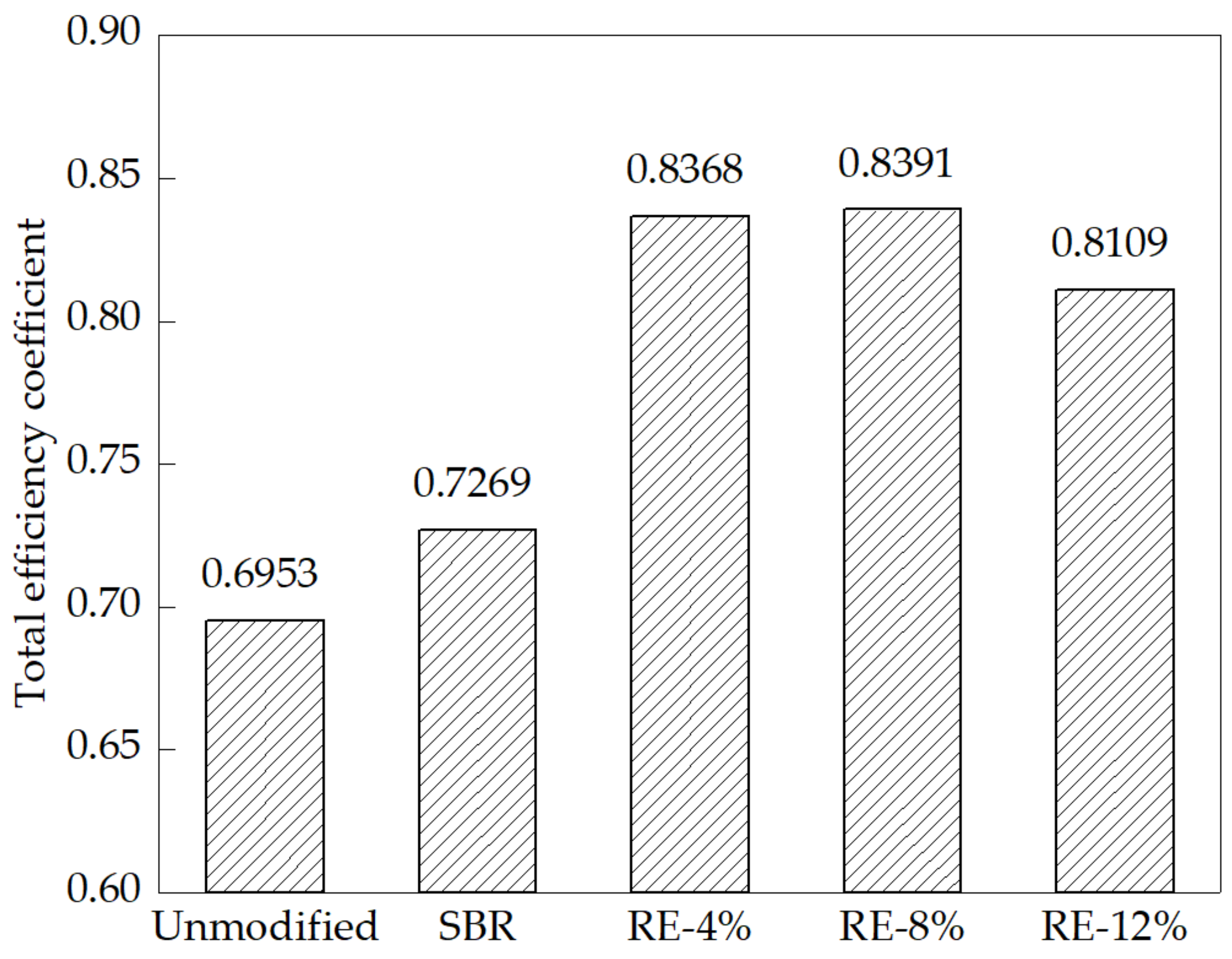1. Introduction
Emulsified asphalt cold recycling technology is a green road construction method with broad application prospects that has the advantages of energy savings, environmental protection, and low cost. It is widely used in asphalt pavement renovation and reconstruction projects [
1,
2]. With the role of the application of this technology in asphalt pavement structure growing (such as with use in the middle course of highways) [
3,
4,
5], higher technical requirements are also being put forward for the performance of cold recycled mixture with asphalt emulsions (CRMEs). Therefore, improving the performance of CRMEs and the application level of the CRME structure layer has become an important problem to be solved by engineers.
In view of the shortcomings of emulsified asphalt cold recycling methods (such as insufficient mechanical performance and poor durability), scholars in various countries have carried out work on improving the performance of cold recycled mixtures. Daryaee evaluated the fatigue resistance, moisture susceptibility and rutting resistance of the CRMEs through a four-point trabecular fatigue test, indirect tensile strength test and dynamic creep test. The results show that the use of regenerant (RE), waste polymer and emulsified asphalt at the same time in 50% reclaimed asphalt pavement (RAP) mixture can significantly enhance the fatigue resistance, rutting resistance and moisture susceptibility of the CRME [
6]. Ali conducted indirect tensile strength test, elastic modulus test, moisture susceptibility test, and dynamic creep test on CRME added with Portland cement, fly ash, and rice husk ash. The test results show that Portland cement is the best effective additives, while the mechanical properties of CRME with fly ash and rice husk ash are not improved much [
7]. Ayar found that cement can improve the short-term and long-term performance of recycled mixture with bitumen emulsion owing to its interaction with asphalt. Slurry lime could superiorly improve the durability of the recycled mixture with bitumen emulsion compared with lime powder [
8]. Wang found that acrylic copolymer emulsion can significantly reduce the air void content and improve the moisture damage resistance of the cold recycled mixtures [
9]. Mohsen performed Marshall stability tests, indirect tensile strength tests, and moisture susceptibility tests on CRMEs of different ages with added cement kiln dust (CKD) and cinder ash (CA). They found that the combined use of CKD and CA can significantly improve the mechanical properties of the cold recycled mixture [
10]. J Jiang prepared three different kinds of latex modified emulsified asphalt cold recycled mixture and researched the rutting resistance of full-depth pavement structures of cold recycled mixtures by high temperature dynamic shear rheology tests and multiple stress creep recovery tests. The test results showed that neoprene latex can significantly enhance the high-temperature performance of cold recycled mixture pavement [
11]. Dongguang Yang investigated the influence of different kinds and contents of fiber on the pavement performance and durability of CRMEs by a four-point bending fatigue test [
12]. Deng studied the influence of mineral filler, machine-made sand, coarse aggregate and other virgin aggregate contents on the performance of emulsified asphalt cold recycled mixture prepared by the vertical vibration compaction method. The research results suggest that the optimal content of mineral filler, machine-made sand and coarse aggregate is 3%, 20% and 10–30%, respectively [
13]. Qingkui Han researched the effect of styrene-butadiene rubber (SBR) latex on the low-temperature performance of CRMEs, and found that SBR latex can significantly improve the flexural stiffness modulus and flexural strength of the CRMEs [
14]. Yafei Li studied the effects of the waterborne epoxy resin on the early strength and durability of CRMEs. The test results showed that waterborne epoxy resin can significantly improve the early strength, high-temperature and low-temperature performance and durability of the mixture [
15]. Cheng Chen carried out laboratory tests and found that rubber powder can markedly improve the early strength, low temperature crack resistance and fatigue performance of cold recycled mixture [
16].
In addition, some scholars have also carried out related research on factors that influence the performance of CRMEs and obtained the following results: Junxiao Li studied the effect of the cement and RAP ratio on the moisture susceptibility of cold recycled mixture. The test results showed that an appropriate content of cement can improve the moisture susceptibility of CRMEs. The higher the RAP content is, the lower the moisture susceptibility of the mixture [
17]. Jinhai Yan used a Cooper testing machine to test the indirect tensile fatigue performance of CRMEs at 15 °C and the stiffness modulus at different temperatures and stress levels [
18]. Stimuli evaluated and analyzed the properties of CRMEs with a high content of old asphalt materials that were used in the lower layer of an expressway. The volume parameters, stiffness, permanent deformation and fatigue properties of the mixture were studied through the testing of road core samples and indoor specimens [
19]. Lyu analyzed the influence of each component content in CRMEs on its comprehensive performance based on the weighted grey target theory. The results show that the content of emulsified asphalt and cement mainly affects the high-temperature performance of cold recycled mixture, while the content of RAP has a greater impact on the moisture susceptibility, and both of the factors can significantly affect the fatigue performance [
20]. Zhang comprehensively analyzed the effects of 10 factors on the low-temperature crack resistance of cold recycled mixture using semicircular bending tests and found that the addition of regenerant improved the low-temperature crack resistance of mixture accounts by more than 60% [
21]. Yuhui Pi studied the strength formation mechanism of CRMEs through microscopic tests and analyzed the influence of aggregate gradation, emulsified asphalt content, water content, and cement content on their strength through laboratory tests. It was finally determined that the optimal contents of emulsified asphalt and cement in the recycled mixture are 2.9% and 1.5%, respectively [
22]. Zhigang Li measured the void ratio, penetration shear strength and unconfined compressive strength after different freeze-thaw cycles to determine the decay law of the mechanical properties and shear strength parameters of the CRMEs [
23].
In recent years, some studies have also involved the microscopic morphology analysis of CRMEs. Tangzhong Wei analyzed the hydration reaction and emulsified asphalt demulsification process in cement emulsified asphalt mortar with the help of scanning electron microscopy (SEM) and other microdetection methods, and found that cement can promote a rapid increase in the early strength of the CRMEs [
24]. Based on the analysis of gel chromatography, infrared spectroscopy and contact angle testing methods, Liang Liu found that after RAP was treated with trichloroethylene and a silane coupling agent-modified Ca(OH)
2 slurry, the performance of the prepared mixture was significantly improved [
25]. Zhigang Li used scanning electron microscopy to observe the surface microscopy morphology of the CRMEs and quantitatively analyzed the cement hydration products by a nanometer- scale measuring instrument. The test results showed that the filler content can remarkably affect the number of fibers produced by cement hydration which have an important role in anchoring reinforcement and crack resistance of CRMEs [
26]. Yanhai Yang carried out scanning electron microscopy observations and electronic energy spectrum analysis of CRMEs with cement. The results showed that cement can react with the water phase of the mixture to form fibrous crystals, which can effectively improve the early strength of the mixture [
27].
In summary, the current research on CRMEs mainly focuses on the effects of Portland cement, lime, epoxy resin, chemical fiber and other modification methods, as well as the influence of factors such as curing temperature and material composition on the mechanical properties, high-temperature performance and low-temperature performance, moisture susceptibility and fatigue performance of CRMEs. Micro-experimental studies on CRMEs have mostly focused on the mechanism of the effect of cement content on the performance of cold recycled mixture, while studies on the performance and micromechanism of CRMEs modified by regenerant are fewer. Therefore, this research conducts laboratory experiments and SEM observation on the performance of CRMEs with different contents of regenerant to analysis of their modification mechanism and evaluation of the effect of modification to further improve the performance of the CRMEs and extend the service life of the recycled pavement.
4. Conclusions
(1) The addition of regenerant can significantly improve the crack resistance at low temperature and the moisture susceptibility of the CRMEs, while SBR latex has not been found to significantly improve the moisture susceptibility and low-temperature crack resistance of CRMEs. The addition of regenerant has a negative impact on the high-temperature performance of CRMEs, and the more regenerant that is used, the worse the high-temperature performance of the CRMEs, while SBR latex can improve the high-temperature performance of the CRMEs.
(2) The master curve of the dynamic modulus of the CRMEs increases gradually in an “s” shape with loading frequency increasing. A proper regenerant content can significantly increase the dynamic modulus of the CRMEs and reduce its temperature sensitivity. The fatigue life of the CRMEs modified with the regenerant and SBR latex is much higher than that of unmodified CRMEs at both low stress and high stress conditions. The improvement in the anti-fatigue performance of the regenerant-modified CRMEs is significant. The greater the content of the regenerant, the more obvious the improvement for the anti-fatigue performance of the CRMEs.
(3) The regenerant can form a composite mortar system with filler, cement and emulsified asphalt such that the interface between the mortar and RAP aggregate has more compactness and uniformity, improving the cohesion of the mixture.
(4) Adding regenerant can significantly improve the moisture susceptibility, low- temperature crack resistance, fatigue resistance and dynamic modulus of CRMEs, but a higher regenerant content does not necessarily create better performance. The order of comprehensive performance of different CRMEs is RE-8% > RE-12% > RE-4% > SBR > unmodified, and the optimal regenerant content is 8%.
